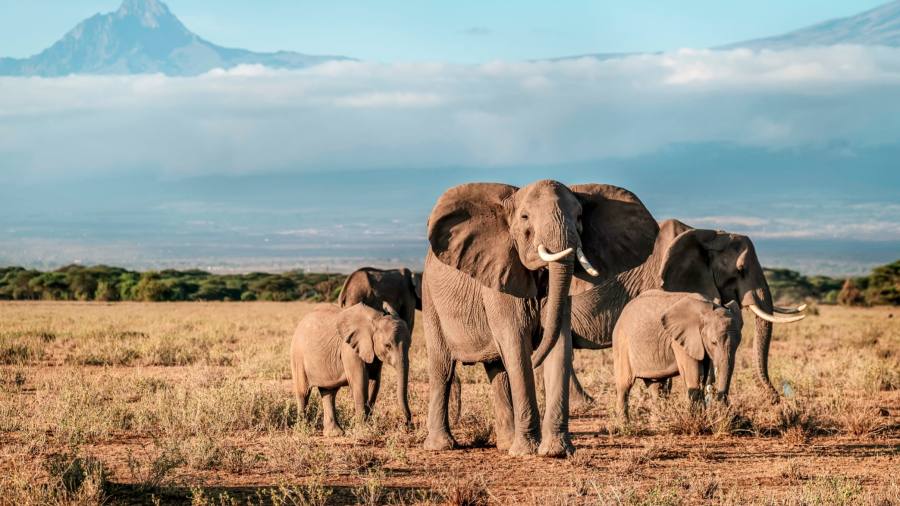Tolstoy, one of east Africa’s few remaining Super Tusker elephants, roamed the open grasslands around Kenya’s Mount Kilimanjaro for more than five decades. That was until last year, when he died after being speared by a farmer seeking to protect his crops.
“This is happening more and more,” said ranger Daudi Ninaai, standing over the animal’s carcass inside the Amboseli ecosystem reserve, whose 2,000 elephants include just five of the Super Tuskers famed for their enormous tusks.
The ranger fears other pachyderms will meet the same fate, as the increasingly frequent clashes between humans and wildlife in the Unesco-designated biosphere are exacerbated by the proliferation of new commercial farms growing crops such as avocados for the west and China. Beijing opened its doors to Kenyan avocados in August and expects to import 20,000 tonnes of the fruit this year.
Incidences of “crop raiding”, where elephants damage or trample cultivated land, more than doubled from 156 in 2020 to 363 last year, according to Big Life, a conservation group.
“It’s skyrocketing . . . because the space is shrinking,” Samuel Tokore, a senior official at Kenya Wildlife Service, said of the human-wildlife conflicts.
Kenya’s elephants, a must-see for tourists who contribute 10 per cent of the country’s gross domestic product, have traditionally been free to traverse through and between its national parks to find food and water, and roam over the border into neighbouring Tanzania.
But the fenced farms growing cash crops have drastically reduced their ability to travel freely. Tall barriers have been thrown up across their ancient migration routes while farmers have shown a willingness to use lethal force to protect their crops.
Such incidents have caused the deaths of more than 50 Amboseli elephants over the past decade. The problem has been heightened by one of the worst droughts on record, which last year killed more than 200 elephants in Kenya alone.
Benson Leyian, Big Life chief executive, said the animals were simply following traditional routes, but the new farms blocked “critical migratory corridors that are key to elephants moving between Amboseli” and nearby Chyulu and Tsavo national parks.
His group has calculated that elephants used one particular route close to the new commercial farms almost 3,000 times last year. Other wildlife, including leopard and giraffe, crossed almost 18,500 times.
Paula Kahumbu, chief executive of conservation group WildlifeDirect, said: “Nobody wants to wonder if they’re contributing to the deaths of elephants — their favourite animal — every time they bite into an avocado from Kenya.”
The problem stems partly from a state-led move to split up 1.35mn acres in Amboseli used by generations of nomadic Maasai into private plots. After the communal land was divided up, some opted to sell them on to commercial farmers.
In one instance, a company called KiliAvo Fresh was awarded a licence for a 180-acre avocado farm on land bought from the Maasai. The license was later revoked after protests, but the farm near the town of Kimana remains fenced off pending appeals.
“We cannot celebrate yet because we want them to be completely defeated and the whole fence to be removed,” said Margret Nayieso, a local Maasai leader. KiliAvo Fresh declined to comment as the “matter is still in court”.
The battle over commercial farming is a glimpse into the wider land use problems in east Africa. Jackson Mwato, head of the Amboseli Ecosystem Trust, an umbrella organisation, said the “mushrooming of farming in the middle of conservation areas or in wildlife corridors” was caused by the “big problem of human population growth”, and a desire to grow food and build homes where land planning was weak.
About 8 per cent of Kenya’s land mass is protected, including 23 national parks and 28 national reserves. Yet WildlifeDirect’s Kahumbu said even this was not enough for the animals to live freely.
“The destruction of wildlife buffer zones and corridors for industrial farming is at a tipping point. We need to reverse the damage, protect more land, secure our protected areas better and open up more corridors between national parks,” she said. Kenya has already lost about 70 per cent of its wildlife over three decades, according to the Kenya Wildlife Conservancies Association.
Silvia Museiya, Kenya’s government’s principal secretary for wildlife, said clearer regulation and more inter-agency co-ordination was needed, but that “at some point everybody has some right to exercise their tenure land rights”.
“But if we do that without a larger scale spatial planning, then we continuously close in the wildlife corridors and forget the fact that animals continuously have to move,” she said. The elephants then “find alternatives that come at a cost”, including destroying property and crops.
The government said in February that Ks5.7bn ($45mn) would be paid to those, mainly farmers, affected by human-wildlife conflict as it rolled out a new insurance scheme. Conservationists have also been able to prevent clashes by erecting about 100km of electric fences to stop the elephants from entering the Maasai lands. Still, the plight of the elephants has led some to reconsider.
Michael Kairu set up his Ngong Veg farming business in Amboseli five years ago only to find out later about the threat it posed to wildlife. His 500-acre farm is located in what was once an elephant breeding ground, according to locals.
“Government agencies and communities should make it clear where you can farm,” said Kairu, whose customers include leading UK supermarkets. “We need to protect wildlife habitats and we also need agriculture.”
His plan is to one day give up the land to conservation, allowing the animals to return. “I don’t want to be in the wrong place,” he said. “I care about elephants.”
Read the full article here





